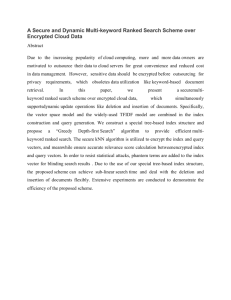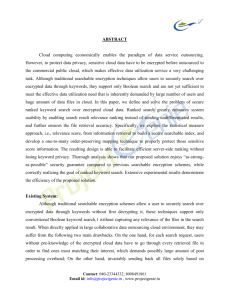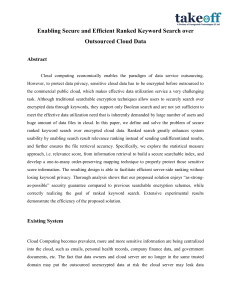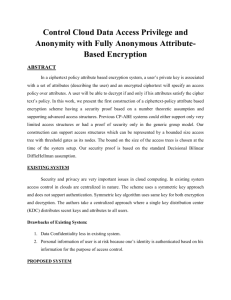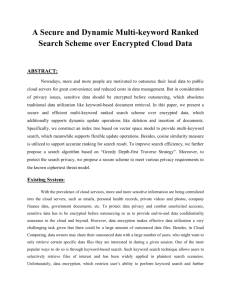International Journal of Application or Innovation in Engineering & Management... Web Site: www.ijaiem.org Email: Volume 3, Issue 6, June 2014
advertisement
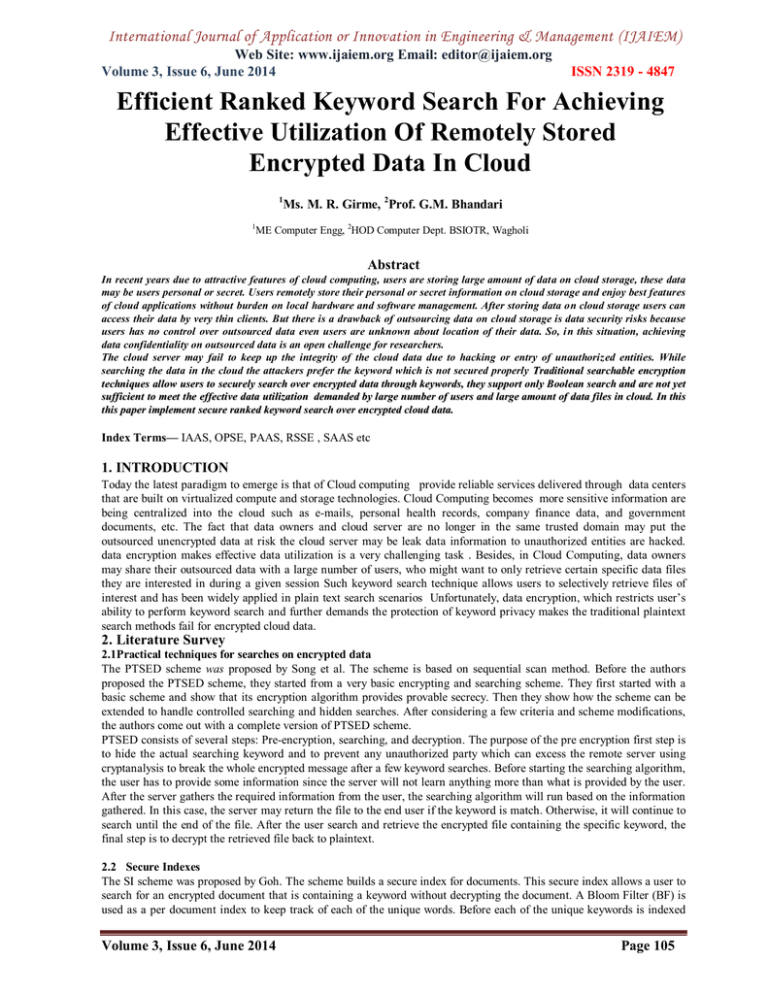
International Journal of Application or Innovation in Engineering & Management (IJAIEM)
Web Site: www.ijaiem.org Email: editor@ijaiem.org
Volume 3, Issue 6, June 2014
ISSN 2319 - 4847
Efficient Ranked Keyword Search For Achieving
Effective Utilization Of Remotely Stored
Encrypted Data In Cloud
1
1
Ms. M. R. Girme, 2Prof. G.M. Bhandari
ME Computer Engg, 2HOD Computer Dept. BSIOTR, Wagholi
Abstract
In recent years due to attractive features of cloud computing, users are storing large amount of data on cloud storage, these data
may be users personal or secret. Users remotely store their personal or secret information on cloud storage and enjoy best features
of cloud applications without burden on local hardware and software management. After storing data on cloud storage users can
access their data by very thin clients. But there is a drawback of outsourcing data on cloud storage is data security risks because
users has no control over outsourced data even users are unknown about location of their data. So, in this situation, achieving
data confidentiality on outsourced data is an open challenge for researchers.
The cloud server may fail to keep up the integrity of the cloud data due to hacking or entry of unauthorized entities. While
searching the data in the cloud the attackers prefer the keyword which is not secured properly Tradi tional sear chable encrypt ion
t echni ques al low users to secur ely search over encrypt ed data through keywords, they s upport onl y B ool ean sear ch and ar e not yet
suff icient to meet t he effecti ve data uti lizat ion demanded by l arge number of users and large amount of data f iles in cl oud. In thi s
t his paper i mplement secure ranked keyword s ear ch over encrypted cl oud data.
Index Terms— IAAS, OPSE, PAAS, RSSE , SAAS etc
1. INTRODUCTION
Today the latest paradigm to emerge is that of Cloud computing provide reliable services delivered through data centers
that are built on virtualized compute and storage technologies. Cloud Computing becomes more sensitive information are
being centralized into the cloud such as e-mails, personal health records, company finance data, and government
documents, etc. The fact that data owners and cloud server are no longer in the same trusted domain may put the
outsourced unencrypted data at risk the cloud server may be leak data information to unauthorized entities are hacked.
data encryption makes effective data utilization is a very challenging task . Besides, in Cloud Computing, data owners
may share their outsourced data with a large number of users, who might want to only retrieve certain specific data files
they are interested in during a given session Such keyword search technique allows users to selectively retrieve files of
interest and has been widely applied in plain text search scenarios Unfortunately, data encryption, which restricts user’s
ability to perform keyword search and further demands the protection of keyword privacy makes the traditional plaintext
search methods fail for encrypted cloud data.
2. Literature Survey
2.1Practical techniques for searches on encrypted data
The PTSED scheme was proposed by Song et al. The scheme is based on sequential scan method. Before the authors
proposed the PTSED scheme, they started from a very basic encrypting and searching scheme. They first started with a
basic scheme and show that its encryption algorithm provides provable secrecy. Then they show how the scheme can be
extended to handle controlled searching and hidden searches. After considering a few criteria and scheme modifications,
the authors come out with a complete version of PTSED scheme.
PTSED consists of several steps: Pre-encryption, searching, and decryption. The purpose of the pre encryption first step is
to hide the actual searching keyword and to prevent any unauthorized party which can excess the remote server using
cryptanalysis to break the whole encrypted message after a few keyword searches. Before starting the searching algorithm,
the user has to provide some information since the server will not learn anything more than what is provided by the user.
After the server gathers the required information from the user, the searching algorithm will run based on the information
gathered. In this case, the server may return the file to the end user if the keyword is match. Otherwise, it will continue to
search until the end of the file. After the user search and retrieve the encrypted file containing the specific keyword, the
final step is to decrypt the retrieved file back to plaintext.
2.2 Secure Indexes
The SI scheme was proposed by Goh. The scheme builds a secure index for documents. This secure index allows a user to
search for an encrypted document that is containing a keyword without decrypting the document. A Bloom Filter (BF) is
used as a per document index to keep track of each of the unique words. Before each of the unique keywords is indexed
Volume 3, Issue 6, June 2014
Page 105
International Journal of Application or Innovation in Engineering & Management (IJAIEM)
Web Site: www.ijaiem.org Email: editor@ijaiem.org
Volume 3, Issue 6, June 2014
ISSN 2319 - 4847
and stored into bloom filter objects, those unique keywords have to go through a pseudorandom function twice. The
purpose of doing so is to make sure that for each two or more documents, if they contain the same keyword the codeword
will represent it differently.
2.3 Searchable symmetric encryption: Improved definitions and efficient constructions
Searchable symmetric encryption (SSE) allows a party to outsource the storage of its data to another party (a server) in a
private manner, while maintaining the ability to selectively search over it. Private-key storage outsourcing allows clients
with either limited resources or limited expertise to store and distribute large amounts of symmetrically encrypted data at
low cost. Since regular private-key encryption prevents one from searching over encrypted data, clients also lose the
ability to selectively retrieve segments of their data. To address this, several techniques have been proposed for
provisioning symmetric encryption with search capabilities the resulting construct is typically called searchable
encryption.
2.4 Public key encryption with keyword search
This paper describes problem of searching on data that is encrypted using a public key system. Consider user Bob who
sends email to user Alice encrypted under Alice's public key. An email gateway want ls to test whether the email contains
the keyword \urgent" so that it could route the email accordingly. Alice, on the other hand does not wish to give the
gateway the ability to decrypt all her messages. They define and construct a mechanism that enables Alice to provide a
key to the gateway that enables the gateway to test whether the word “urgent" is a keyword in the email without learning
anything else about the email. This mechanism as Public
Key Encryption with keyword Search.
2.5 Order-preserving symmetric encryption
This paper contains the cryptographic study of order-preserving symmetric encryption (OPSE), a primitive suggested in
the database community by Agrawal et al for allowing efficient range queries on encrypted data. These are deterministic
encryption schemes (aka. ciphers) whose encryption function preserves numerical ordering of the plaintexts. In fact, OPE
not only allows efficient range queries, but allows indexing and query processing to be done exactly and as efficiently as
for unencrypted data, since a query just consists of the encryptions of a and b and the server can locate the desired cipher
texts in logarithmic-time via standard tree-based data structures.
3. Existing systems:
Although traditional searchable encryption schemes allow a user to securely search over encrypted data through keywords
without first decrypting it, these techniques support only conventional Boolean keyword search,1 without capturing any
relevance of the files in the search result. When directly applied in large collaborative data outsourcing cloud
environment, they may suffer from the following two main drawbacks. On the one hand, for each search request, users
without knowledge of the encrypted cloud data have to go through every retrieved file in order to find ones most
matching their interest, which demands possibly large amount of post processing overhead On the other hand, invariably
sending back all files solely based on presence absence of the keyword further incurs large unnecessary network traffic,
which is absolutely undesirable in today’s pay-as-you-use cloud paradigm. In short lacking of effective mechanisms to
ensure the file retrieval accuracy is a significant drawback of existing searchable encryption schemes in the context of
Cloud Computing.
PROBLEM STATEMENT
The existing technique resolves the optimization complexities in ranked keyword search and its effective utilization of
remotely stored encrypted cloud data. But it limits the further optimizations of the search results by preventing search
engine to interact with cloud users to maintain the integrity of actual owner’s keyword and the data associated with it.
Consider an encrypted cloud data hosting service involving three different entities, as illustrated in Fig 1data owner, data
user, and cloud server. Data owner has a collection of n data files that he wants to outsource on the cloud server in
encrypted form while still keeping the capability to search through them for effective data utilization reasons.
Now consider the secure ranked keyword search problem as follows: the search result should be returned according to
certain ranked relevance criteria (e.g., keyword frequency-based scores, as will be introduced shortly), to improve file
retrieval accuracy for users without prior knowledge on the file collection. We primarily consider an “honest-but-curious”
server in our model, which is consistent with most of the previous searchable encryption schemes.
The problem with the techniques available for implementing search engine in an environment consists of sensitive
outsourced cloud data can be summarized as:
a) Lacking of effective mechanisms to ensure the file retrieval accuracy is very difficult.
b) Security is not addressed fully and limits search engine’s accuracy.
Volume 3, Issue 6, June 2014
Page 106
International Journal of Application or Innovation in Engineering & Management (IJAIEM)
Web Site: www.ijaiem.org Email: editor@ijaiem.org
Volume 3, Issue 6, June 2014
ISSN 2319 - 4847
The ranked keyword search over encrypted data is to achieve economies of scale for Cloud Computing. This process start
from the review of existing searchable symmetric encryption schemes and provides the definitions and framework for this
proposed ranked searchable symmetric encryption.
Figure 1 Ranked keyword search in cloud model
4. Proposed systems:
Therefore, how to enable a searchable encryption system with support of secure ranked search is the problem tackled in
this paper. Our work is among the first few ones to explore ranked search over encrypted data in Cloud Computing.
Ranked search enhances system usability by returning the matching files in a ranked order regarding to certain relevance
criteria (e.g., keyword frequency).Thus making one step closer toward practical deployment of privacy-preserving data
hosting services in the context of Cloud Computing. To achieve our design goals on both system security and usability, we
propose to bring together the advance of both crypto and IR community to design the ranked searchable symmetric
encryption (RSSE) scheme, in the spirit of “as-strong-as-possible” security guarantee. Specifically, we explore the
statistical measure approach from IR and text mining to embed weight information (i.e., relevance score) of each file
during the establishment of searchable index before outsourcing the encrypted file collection. As directly outsourcing
relevance scores will leak lots of sensitive frequency information against the keyword privacy, we then integrate a recent
crypto primitive order-preserving symmetric encryption (OPSE) and properly modify it to develop a one to- many orderpreserving mapping technique for our purpose to protect those sensitive weight information, while providing efficient
ranked search functionalities.
Our contribution can be summarized as follows:
1. For the first time, we define the problem of secure ranked keyword search over encrypted cloud data, and provide such
an effective protocol, which fulfills the secure ranked search functionality with little relevance score information leakage
against keyword privacy.
2. Thorough security analysis shows that our ranked searchable symmetric encryption scheme indeed enjoys “as-strongas-possible” security guarantee compared to previous searchable symmetric encryption (SSE) schemes.
3. We investigate the practical considerations and enhancements of our ranked search mechanism, including the efficient
support of relevance score dynamics, the
authentication of ranked search results and the reversibility of our proposed one to many order preserving mapping
technique.
4. Extensive experimental results demonstrate the effectiveness and efficiency of the proposed solution
Design Goals:
To enable ranked keyword search for effective utilization of outsourced cloud data under the aforementioned model, our
system design should achieve the following security and performance guarantee.
a) Ranked keyword search: For efficient searching process the process use the mechanism of Topic detection and
tracking The search time includes fetching the posting list in the index, decrypting, and rank ordering each entry.
b) Security guarantee: For providing the security in the cloud server, this process uses the privilege method.
5. Design Process
Software design is a process through which the requirements are translated in to a representation of the software i.e. the
blue print for constructing software. Design provides us with representation of software that can be assesses for quality.
Design is the only way that we can accurately translating a customer’s requirements in to a finished software product.
Some of the fundamental concepts of software design include Abstraction, Refinement, Modularity, Software
Architecture, Control Hierarchy, Structured Partitioning, Data Structure, Software Procedure and also the Information
Hiding.
Volume 3, Issue 6, June 2014
Page 107
International Journal of Application or Innovation in Engineering & Management (IJAIEM)
Web Site: www.ijaiem.org Email: editor@ijaiem.org
Volume 3, Issue 6, June 2014
ISSN 2319 - 4847
5.1 Supporting Score Dynamics
In Cloud Computing, outsourced file collection might not only be accessed but also updated frequently for various
application purposes (see [10]–[11], for example). Hence, supporting the score dynamics in the searchable index for an
RSSE system, which is reflected from the corresponding file collection updates, is thus of practical importance. Here we
consider score dynamics as adding newly encrypted scores for newly created files, or modifying old encrypted scores for
modification of existing files in the file collection. Ideally, given a posting list in the inverted index, the encryption of all
these newly changed scores should be incorporated directly without affecting the order of all other previously encrypted
scores, and we show that our proposed one-to-many order-preserving mapping does exactly that. Note that we do not
consider file deletion scenarios because it is not hard to infer that deleting any file and its score does not affect the
ranking orders of the remaining files in the searchable index.
5.2 Reversing One-to-many Order-preserving Mapping
For any order-preserving mapping process, being reversible
is very useful in many practical situations, especially when the underlying plaintext values need to be modified or utilized
for further computation purposes. While OPSE, designed as a block cipher, by-default has this property, it is not yet clear
whether our one-to-many order-preserving mapping can be reversible too. the reversibility of the proposed one-to-many
order-preserving mapping can be observed from the BinarySearch() procedure in Algorithm 1. The intuition is that the
plain text-to-bucket mapping process of OPSE is reversible.
6. System architecture
We consider an encrypted cloud data hosting service involving three different entities: data owner, data user, and cloud
server as in fig.1 Data owner has a collection of n data files C= (f1, f2...fn) that he wants to outsource on the cloud server
in encrypted form while still keeping the capability to search through them for effective data utilization reasons. To do so,
before outsourcing, data owner will first build a secure searchable index I from a set of m distinct keywords W = (w1,
w2…wm) extracted from the file collection C, and store both the index I and the encrypted file collection C on the cloud
server. We assume the authorization between the data owner and users is appropriately done.
To search the file collection for a given keyword w, an authorized user generates and submits a search request in a secret
form—a trapdoor Tw of the keyword w to the cloud server. Upon receiving the search request Tw, the cloud server is
responsible to search the index I and return the corresponding set of files to the user. We consider the secure ranked
keyword search problem as follows: the search result should be returned according to certain ranked relevance criteria.
With focus on the index and query, the system consists of four algorithms in two phases, Setup and Retrieval:
Fig 1: System Architecture
6.1 Secure Ranked Keyword Search over Cloud Data
Development of a private cloud is very expensive. Storage of sensitive data in public cloud is very risky. To make it
possible, unauthorized access is avoided by storing the data in encrypted format. This paper tackles the problems of
enabling searchable encryption system with support of secure ranked search in order to implement the top k retrieval. In
this paper, statistical measure approach from IR and text mining to embed weight information of each file during
establishment of searchable index before outsourcing the encrypted file collection is explored. Team frequency: Number
of times a particular keyword appears within the file. Inverse document frequency (IDF): It is calculated as the total
number of files by the number of files in particular keyword. Ranking function: It is calculated by using TF*IDF rule.
Information leakage is avoided by using one too many order preserving mapping. The basic scheme, security of ranked
searchable encryption is the same as previous SSE schemes, i.e. the users gets the ranked results without letting cloud
server learn any additional information more than the access pattern and search pattern. The scheme clearly satisfies the
security guarantee of SSE, i.e. only the access pattern and search pattern is leaked. however , ranking is done on the user
side, which may bring in huge computation and post processing overhead. Moreover, sending back all the files consumes
large undesirable bandwidth. In this way, server still learns nothing about the values of relevance scores, but it knows the
Volume 3, Issue 6, June 2014
Page 108
International Journal of Application or Innovation in Engineering & Management (IJAIEM)
Web Site: www.ijaiem.org Email: editor@ijaiem.org
Volume 3, Issue 6, June 2014
ISSN 2319 - 4847
requested files are more relevant than the unrequested ones, which inevitably leaks more information than the access
pattern and search pattern [15]. For efficient use of outsourced cloud data, enabling ranked searchable
encryption is the purpose of this approach. The main goals of this system are: I) Ranked keyword search ii) Security
guarantee iii) Efficiency.
Fig 2: Architecture of the search over encrypted cloud data
Considering a cloud data hosting service with three different entities i.e. data owner (O), data user (U), and cloud server
(CS). Data owner has a collection of data files C = (F1, F2, FN) that he wants to outsource on the cloud server in
encrypted form. for doing this ,before outsourcing, on cloud server data owner will first build a secure searchable index I
from a set of m distinct keywords W = (w1, w2, wm) extracted from the file collection C, and store both the index I and
the encrypted file collection C on the cloud server. [15] Considering that the authorization between the data owner and
users is properly done. A certified user submits a keyword search request in a secret form —a trapdoor Two of the
keyword—to the cloud server. Upon receiving the search request Two, the cloud server is responsible to search the index I
and return the equivalent set of files to the user. The secure ranked keyword search problem is: result of the submitted
search should be returned according to certain ranked relevance criteria (e.g., keyword frequency based scores), to
improve file retrieval accuracy for users without previous knowledge on the file collection C. The searching in the
encrypted data is done by using ranking function and the retrieved results are authenticated. [15], [16]
[6], [7]. The problem with this is that only the dataset is considered in plaintext and there is requirement of searchable
field to define some kind of ordering, which is hard to achieve when the data is encrypted. A new cryptographic primitive
is introduced called Order Preserving Encryption (OPE) [8], which reserves the order of the data after the data is
encrypted. Therefore, one original authentication scheme for the authenticity and completeness of the query results are
required for all of the cloud users. The two threats to query replies under this model are: 1) searchable encryption 3)
message authentication code .In this one scheme for CSPs is proposed to the proof of a query results for the cloud users
and then it is demonstrated that this scheme uniquely achieves the authentication and completeness of the query results
from the CSPs. Secondly, conduction of an extensive computation and communication analysis is performed. This makes
the scheme both practical and feasible for the cloud users. The system models consist of entities.1) Cloud Storage Client
(CSC) stores a large number of data in cloud storage server. A CSC could be an individual user or an organization. 2)
Cloud Storage Provider (CSP) provides search-based secure retrieval services for cloud storage client. A CSP has rich
storage space and computation power to manage the data of CSCs. 3) Trusted Authority (TA) is trusted by all the other
system entities, and issues identification to them. [9] The system model consists of 3 system entities: CSC encrypts the
data and generates MAC .CSP; here data corresponding to MAC is stored. The proposed scheme ensures secure and
efficient authentication to assure the security of query results. It takes advantages of the PEKS scheme to construct
searchable indexes. The design ensures that the encrypted file indeed contains certain keywords without decrypting the
files. There is introduction of a counter for each keyword to assure the completeness of query results. Because no
unqualified files can be included without being caught and the number of returned files is correct, the CSC can be assured
of the correctness of the query results.
Fig 3: Cloud Storage Access Model
6.2 Authenticated and Complete Query Results from Cloud Storages
The query results can be considered only by evaluating two aspects: first is the authentication and the other is the
completeness of the query results. The authentication of the retrieved data is done by verifying the corresponding digital
signatures one after the. The goal can also be achieved by using authenticated data structures including signature
aggregation [3], signature chaining [4], or hash tree structure [5]. The requirement of computation of an aggregated value
by the users in these designs renders this computation intensive. Along with this there is no guarantee of completion of
Volume 3, Issue 6, June 2014
Page 109
International Journal of Application or Innovation in Engineering & Management (IJAIEM)
Web Site: www.ijaiem.org Email: editor@ijaiem.org
Volume 3, Issue 6, June 2014
ISSN 2319 - 4847
results, only authentication of returned data is ensured. The most applicable research is verifying the completeness of the
query results from the database management system (DBMS)
7. Modules
Encrypted File Outsource/Upload module
In this module owner can upload file to cloud server. Whole file data is encrypted by server and stored to server.
Keyword Indexing Module
In this module keyword from document will be extracted and index of such keywords along with the list of documents
which contains keywords. This index is also encrypted. Index building is done using below algorithm.
User Query module
In this module User searches documents by using keywords. Relevance score of document is calculated for searched
keywords for documents whose keywords are matched. Based on this calculated relevance score, and result will be
displayed according to this relevance score.
Document Retrieval module
Finally decrypted document is given to user if authentication is made between them. Whole process don only in encrypted
form
8. Mathematical Model Design: Notation
Q denotes the searched keywords
Fd,t denotes the TF of term t in file Fd;
ft denotes the number of files that contain term t;
N denotes the total number of files in the
collection; and |Fd| is the length of file Fd, obtained by
counting the number of indexed terms Relevance score of document is calculated for searched keywords for documents
whose keywords are matched. Based on this calculated relevance score, and result will be displayed according to this
relevance score.
Score (Q,Fd ) =
. (1+ln fd,t) . ln(1+N/ft)
9. Algorithms
2) AES
3) OPM
4) Build index
Algorithm 1: AES algorithms structure for encryption and decryption
Volume 3, Issue 6, June 2014
Page 110
International Journal of Application or Innovation in Engineering & Management (IJAIEM)
Web Site: www.ijaiem.org Email: editor@ijaiem.org
Volume 3, Issue 6, June 2014
ISSN 2319 - 4847
Algorithm 2 One-to-many Order-preserving Mapping- OPM
1: procedure OPMK (D;R; m; id(F))
2: while |D| ! = 1 do
3:
{D, R} ← BinarySearch(K,D,R,m);
4: end while
5: coin
TapeGen(K,(D,R, 1||m, id(F)));
6: c
R;
7: return c;
8: end procedure
9: procedure BinarySearch(K,D,R,m);
10: M ← |D|; N ← |R|;
11: d ← min (D)-1; r ← min (R) - 1;
12: y ← r + [N/2];
13: coin
TapeGen(K,(D,R, 0||y));
14: x
d + HYGEINV (coin,M,N, y -r);
15: if m <=x then
16:
D ← {d + 1,…..,x};
17:
R ←{r + 1………, y};
18: else
19:
D ← {x + 1,…….., d +M};
20:
R ←{y + 1,………, r + N};
21: end if
22: return {D, R};
23: end procedure
Algorithm 3 Build Index(K, C)
1. Initialization:
i) Scan C and extract the distinct words W = (w1,w2,………,wm) from C.
For each wi ε W, build F (wi);
2. Build posting list:
i) For each wi ε W
for 1 <=j <=|F(wi) |
a) Calculate the score for file Fij and denoted as Sij ;
b) Compute εz(Sij ), and store it with Fij ’s identifier
(id(Fij )||εz(Sij )) in the posting list I(wi);
3. Secure the index I:
i) For each I (wi) where 1 <= i _<=m:
Encrypt all Ni entries with l` padding 0’s, (0l`||0(id(Fij )||εz(Sij )),with key fy(wi), where 1 <= j <=v.
Set remaining v-Ni entries, if any, to random values of the same size as the existing Ni entries of I (wi).
Replace wi with "π" x(wi);
4. Output I
10. System Requirement
10.1 Hardware specification
Processor
Hard Disk
Floppy Drive
Monitor
Mouse
RAM
Pentium IV 2.4 GHz.
40 GB
1.44 Mb
15 VGA Colour
Logitech
512
10.2 Software Specification
Operating system
Windows XP.
Front end
JAVA,Swing,RMI,
J2me(WirelessToolkit)
Volume 3, Issue 6, June 2014
Page 111
International Journal of Application or Innovation in Engineering & Management (IJAIEM)
Web Site: www.ijaiem.org Email: editor@ijaiem.org
Volume 3, Issue 6, June 2014
Back end
Tool Used
ISSN 2319 - 4847
My SQL
Eclipse 3.3
11. Result
12. CONCLUSION
We motivate and solve the problem of supporting efficient ranked keyword search for achieving effective utilization of
remotely stored encrypted data in Cloud Computing. We then appropriately weaken the security guarantee, resort to the
newly developed crypto primitive OPSE, and derive an efficient one-to-many order-preserving mapping function, which
allows the effective RSSE to be designed.
REFERENCES
[1] Cong Wang, Ning Cao, Kui Ren , Wenjing Lou, Senio(2012), “Enabling Secure and Efficient Ranked Keyword
Search over Outsourced Cloud Data”, IEEE Transactions on Parallel and Distributed systems, VOL.23,NO.8.
[2] C. Wang, N. Cao, J. Li, K. Ren, and W. Lou, “Secure ranked keyword search over encrypted cloud data,” in Proc. of
ICDCS’10,2010.
[3] Dawn Xiaodong Song David Wagner Adrian Perrig, “Practical Techniques for Searches on Encrypted
Data”Proc.IEEE Symp.Security and Privacy, 2000.
[4] Alexandra Boldyreva, Nathan Chenette, Younho Lee, and Adam O’Neill Georgia, “Order-Preserving Symmetric
Encryption”, in Proc. of Eurocrypt’09, volume 5479 of LNCS. Springer, 2009.
[5] E.-J. Goh, “Secure indexes” ,Cryptology ePrint Archive, Report 2003/216.
[6] D. Boneh, G. D. Crescenzo, R. Ostrovsky, and G. Persiano, “Public key encryption with keyword search,” in Proc. of
EUROCRYP’04,volume 3027 of LNCS. Springer, 2004.
Volume 3, Issue 6, June 2014
Page 112
International Journal of Application or Innovation in Engineering & Management (IJAIEM)
Web Site: www.ijaiem.org Email: editor@ijaiem.org
Volume 3, Issue 6, June 2014
ISSN 2319 - 4847
[7] R. Curtmola, J. A. Garay, S. Kamara, and R. Ostrovsky, “Searchable symmetric encryption: improved definitions and
efficient constructions,” in Proc. of ACM CCS’06, 2006.
[8] J. Li, Q. Wang, C. Wang, N. Cao, K. Ren, and W. Lou, “Fuzzy keyword search over encrypted data in cloud
computing,” in Proc.of IEEE INFOCOM’10 Mini-Conference, 2010.
[9] Kiruthigapriya Sengoden, Swaraj Paul,”Improving the Efficiency of Ranked keyword Search over Cloud Data”,in
proc of International Journal of Advanced Research in Computer Engineering & Technology (IJARCET) Volume 2,
Issue 3, March 2013
[10] Q. Wang, C. Wang, K. Ren, W. Lou, and J. Li, “Enabling Public Verifiability and Data Dynamics for Storage
Security in Cloud Computing,” IEEE Transactions on Parallel and Distributed Systems (TPDS), vol. 22, no. 5, pp.
847–859, May 2011.
M.Girme received her B.E degree in Computer Engineering from Pune University, India, in 2007. Currently
pursuing M.E. in computer engineering at JSPM Institute, pune, India. His
interesting research area is Cloud Computing, Network. Security
Prof. G.M.Bhandari received her B.E degree in Computer Engineering from Pune University, India, in
2001.and M.E. in computer 2008 from pune university Currently pursuing PHD in computer
engineering from JJT University , Rajasthan , India. interesting research area is Cloud Computing,
Network. Security,Wireless Sercurity,Data Mining
Volume 3, Issue 6, June 2014
Page 113
